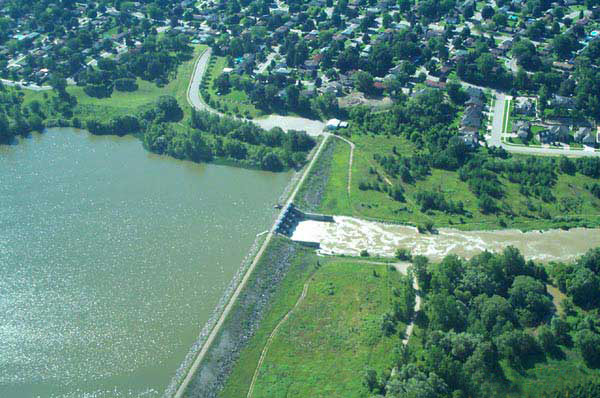Pittock Dam and Reservoir

Design concepts for Pittock Dam were prepared in the Upper Thames Valley Conservation Report (1952) with the objectives of providing flood protection to downstream communities and improving base flows during the drier summer months.
In 1961 engineering designs commenced to find the best combination of works in the Woodstock area. The present location was chosen over two smaller dams on the Thames and on Cedar Creek near Woodstock. Construction was started on the dam in 1964 and officially completed in 1967. The cost of the dam and land base at that time was close to $6 million. Present annual maintenance costs are about $40,000.
Operating Features
Pittock Dam is designed for both flood control and flow augmentation purposes. The outflow from the dam is controlled by three main operating features:
- Five large radial arm gates coarse control of flows from the dam. These gates are used mainly during the spring runoff period (March to April), as well as in the fall when the soil is likely to be frozen or saturated and runoff from snowmelt or rainfall is potentially high. Some gates are also left open in the winter when the water level in the reservoir is lower to make the winter ice cover as stable as possible.
- A small slide gate valve provides fine control of outflow during the summer to provide small releases to downstream when often even less flow enters into the reservoir. The valve can also discharge cooler water from the bottom of the reservoir during the summer. The low setting of the gate allows the reservoir to be further lowered for maintenance purposes if required.
- Steel stop logs provide some automatic control during the summer months when the reservoir level is at or close to its highest level, by allowing flow to spill over the logs when the water levels rise following summer storms. Some water level fluctuations may result.
Reservoir Operations
A minimum volume of water is released downstream during the summer months. An annual operating cycle guideline was established within the original design for the dam and reservoir. The cycle indicates substantial fluctuations in water levels during the year. These changes provides optimum year round flood control capability to protect downstream communities without endangering the safe operation of the dam, and benefits water quality downstream during dry summer conditions.
Safety around Dams (MNRF webpage)

